Ivan Laptev
WILLOW, LIENS
Learning to Answer Visual Questions from Web Videos
May 11, 2022
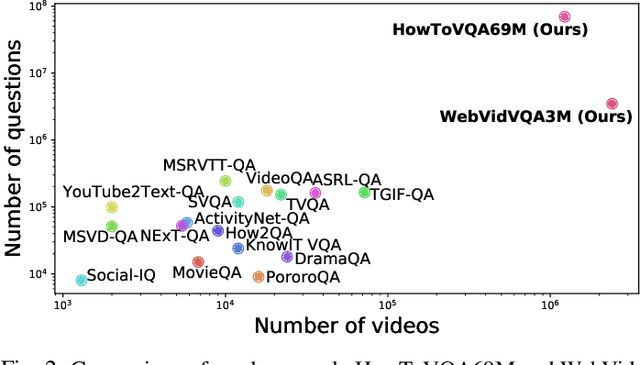
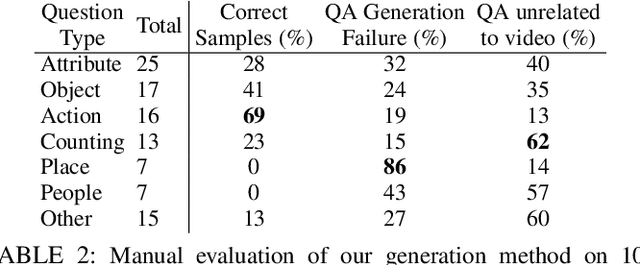
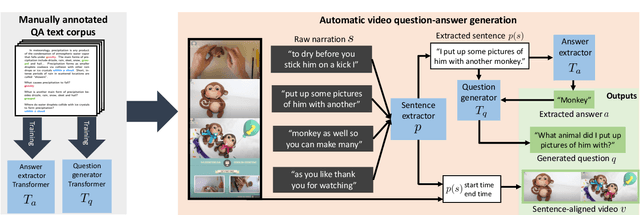
Abstract:Recent methods for visual question answering rely on large-scale annotated datasets. Manual annotation of questions and answers for videos, however, is tedious, expensive and prevents scalability. In this work, we propose to avoid manual annotation and generate a large-scale training dataset for video question answering making use of automatic cross-modal supervision. We leverage a question generation transformer trained on text data and use it to generate question-answer pairs from transcribed video narrations. Given narrated videos, we then automatically generate the HowToVQA69M dataset with 69M video-question-answer triplets. To handle the open vocabulary of diverse answers in this dataset, we propose a training procedure based on a contrastive loss between a video-question multi-modal transformer and an answer transformer. We introduce the zero-shot VideoQA task and the VideoQA feature probe evaluation setting and show excellent results, in particular for rare answers. Furthermore, our method achieves competitive results on MSRVTT-QA, ActivityNet-QA, MSVD-QA and How2QA datasets. We also show that our VideoQA dataset generation approach generalizes to another source of web video and text data. We use our method to generate the WebVidVQA3M dataset from the WebVid dataset, i.e., videos with alt-text annotations, and show its benefits for training VideoQA models. Finally, for a detailed evaluation we introduce iVQA, a new VideoQA dataset with reduced language bias and high-quality manual annotations. Code, datasets and trained models are available at https://antoyang.github.io/just-ask.html
TubeDETR: Spatio-Temporal Video Grounding with Transformers
Mar 30, 2022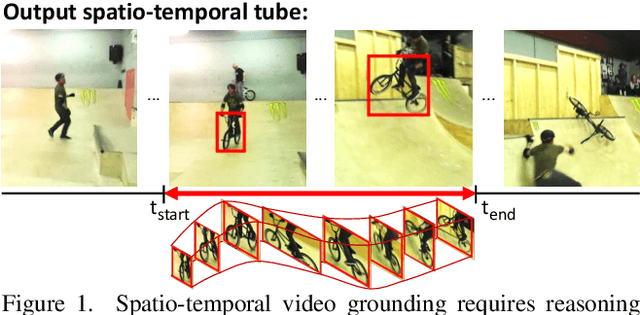
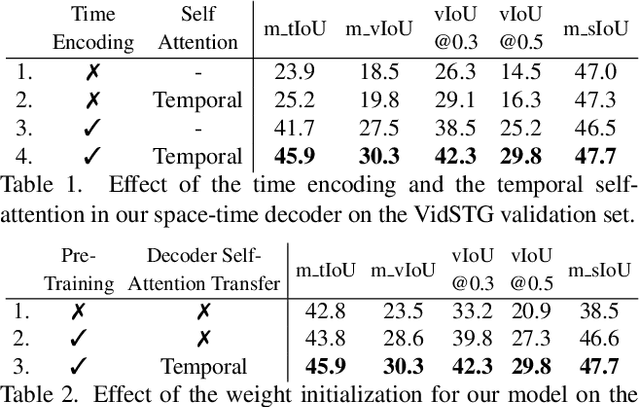
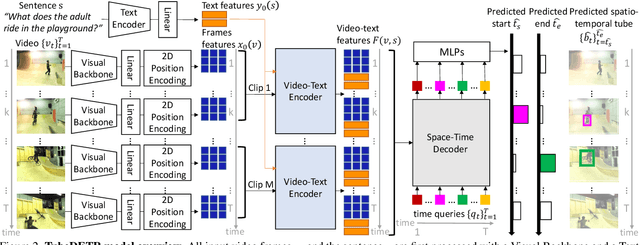

Abstract:We consider the problem of localizing a spatio-temporal tube in a video corresponding to a given text query. This is a challenging task that requires the joint and efficient modeling of temporal, spatial and multi-modal interactions. To address this task, we propose TubeDETR, a transformer-based architecture inspired by the recent success of such models for text-conditioned object detection. Our model notably includes: (i) an efficient video and text encoder that models spatial multi-modal interactions over sparsely sampled frames and (ii) a space-time decoder that jointly performs spatio-temporal localization. We demonstrate the advantage of our proposed components through an extensive ablation study. We also evaluate our full approach on the spatio-temporal video grounding task and demonstrate improvements over the state of the art on the challenging VidSTG and HC-STVG benchmarks. Code and trained models are publicly available at https://antoyang.github.io/tubedetr.html.
Look for the Change: Learning Object States and State-Modifying Actions from Untrimmed Web Videos
Mar 22, 2022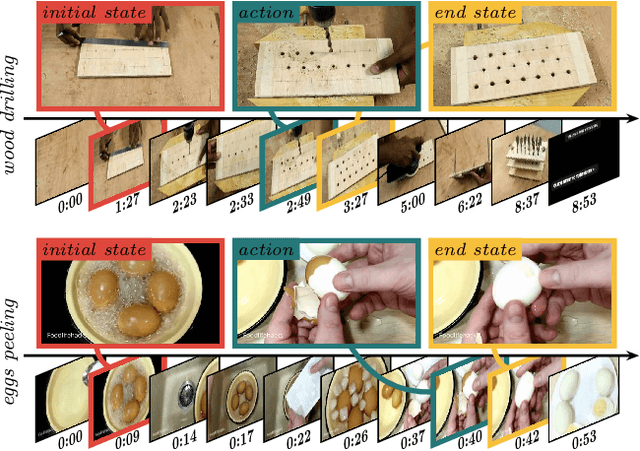
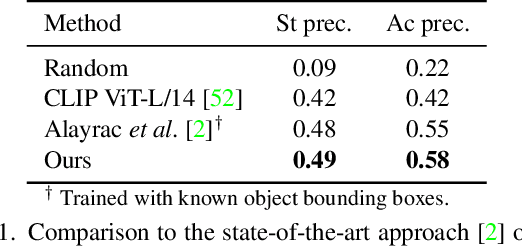
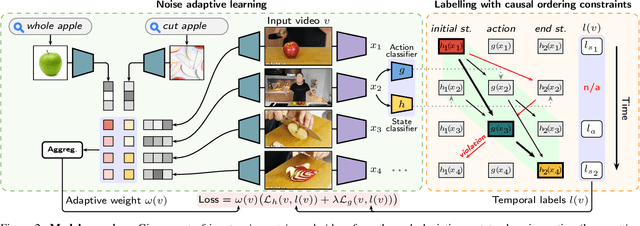
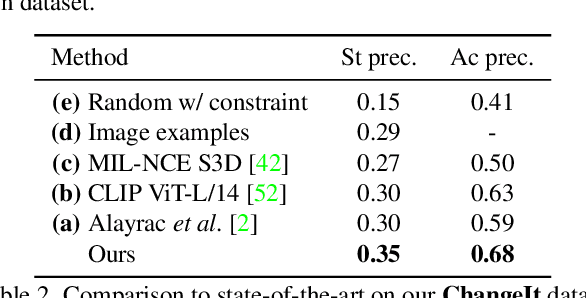
Abstract:Human actions often induce changes of object states such as "cutting an apple", "cleaning shoes" or "pouring coffee". In this paper, we seek to temporally localize object states (e.g. "empty" and "full" cup) together with the corresponding state-modifying actions ("pouring coffee") in long uncurated videos with minimal supervision. The contributions of this work are threefold. First, we develop a self-supervised model for jointly learning state-modifying actions together with the corresponding object states from an uncurated set of videos from the Internet. The model is self-supervised by the causal ordering signal, i.e. initial object state $\rightarrow$ manipulating action $\rightarrow$ end state. Second, to cope with noisy uncurated training data, our model incorporates a noise adaptive weighting module supervised by a small number of annotated still images, that allows to efficiently filter out irrelevant videos during training. Third, we collect a new dataset with more than 2600 hours of video and 34 thousand changes of object states, and manually annotate a part of this data to validate our approach. Our results demonstrate substantial improvements over prior work in both action and object state-recognition in video.
Leveraging Randomized Smoothing for Optimal Control of Nonsmooth Dynamical Systems
Mar 11, 2022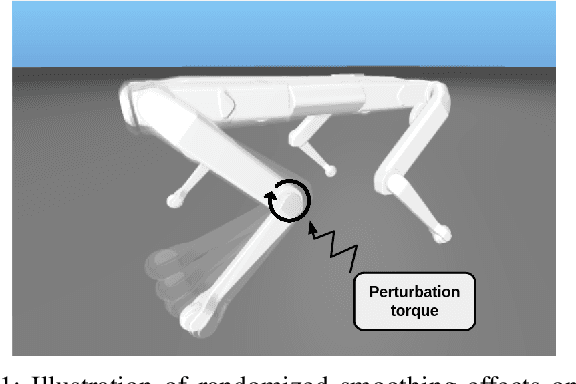
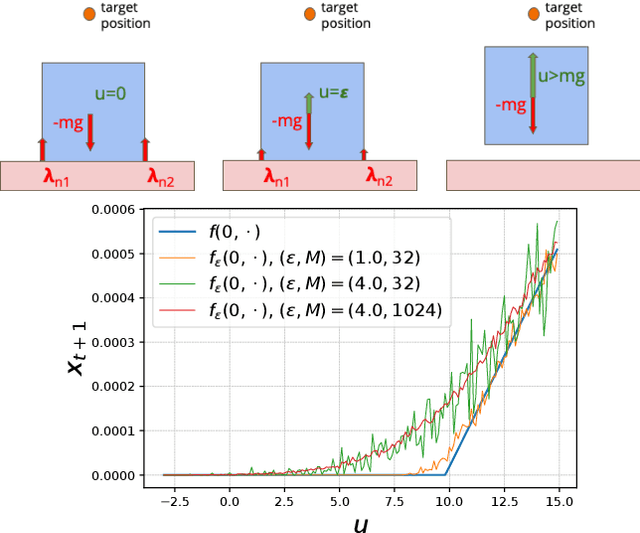
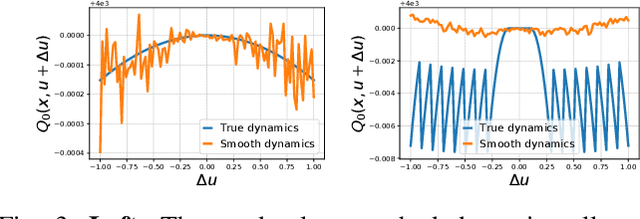

Abstract:Optimal control (OC) algorithms such as Differential Dynamic Programming (DDP) take advantage of the derivatives of the dynamics to efficiently control physical systems. Yet, in the presence of nonsmooth dynamical systems, such class of algorithms are likely to fail due, for instance, to the presence of discontinuities in the dynamics derivatives or because of non-informative gradient. On the contrary, reinforcement learning (RL) algorithms have shown better empirical results in scenarios exhibiting non-smooth effects (contacts, frictions, etc). Our approach leverages recent works on randomized smoothing (RS) to tackle non-smoothness issues commonly encountered in optimal control, and provides key insights on the interplay between RL and OC through the prism of RS methods. This naturally leads us to introduce the randomized Differential Dynamic Programming (R-DDP) algorithm accounting for deterministic but non-smooth dynamics in a very sample-efficient way. The experiments demonstrate that our method is able to solve classic robotic problems with dry friction and frictional contacts, where classical OC algorithms are likely to fail and RL algorithms require in practice a prohibitive number of samples to find an optimal solution.
Think Global, Act Local: Dual-scale Graph Transformer for Vision-and-Language Navigation
Feb 23, 2022
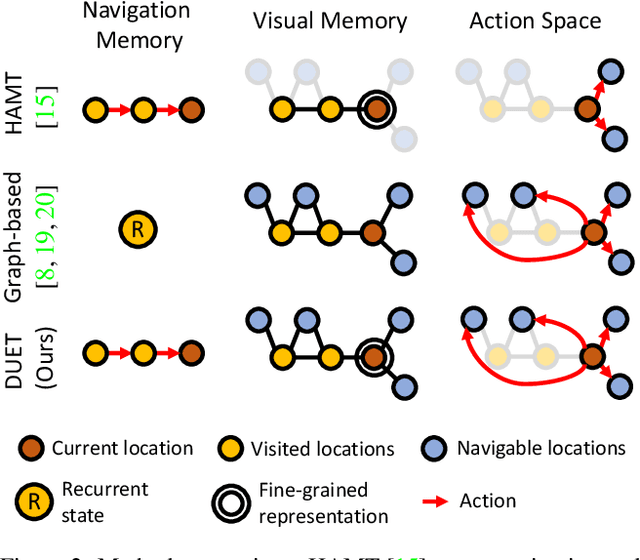


Abstract:Following language instructions to navigate in unseen environments is a challenging problem for autonomous embodied agents. The agent not only needs to ground languages in visual scenes, but also should explore the environment to reach its target. In this work, we propose a dual-scale graph transformer (DUET) for joint long-term action planning and fine-grained cross-modal understanding. We build a topological map on-the-fly to enable efficient exploration in global action space. To balance the complexity of large action space reasoning and fine-grained language grounding, we dynamically combine a fine-scale encoding over local observations and a coarse-scale encoding on a global map via graph transformers. The proposed approach, DUET, significantly outperforms state-of-the-art methods on goal-oriented vision-and-language navigation (VLN) benchmarks REVERIE and SOON. It also improves the success rate on the fine-grained VLN benchmark R2R.
Are Large-scale Datasets Necessary for Self-Supervised Pre-training?
Dec 20, 2021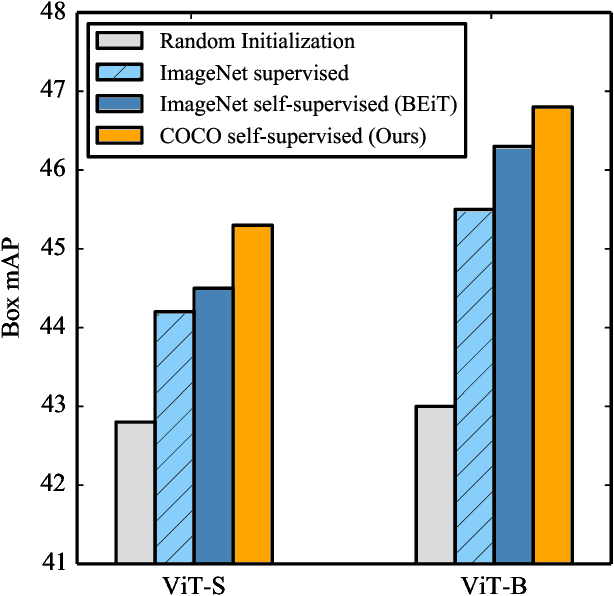
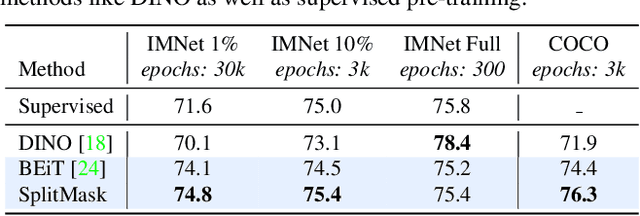
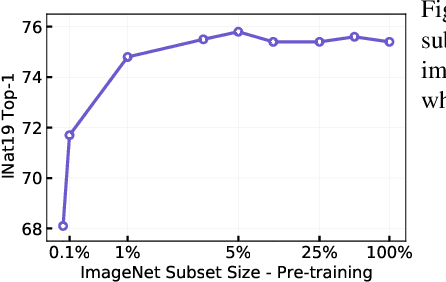

Abstract:Pre-training models on large scale datasets, like ImageNet, is a standard practice in computer vision. This paradigm is especially effective for tasks with small training sets, for which high-capacity models tend to overfit. In this work, we consider a self-supervised pre-training scenario that only leverages the target task data. We consider datasets, like Stanford Cars, Sketch or COCO, which are order(s) of magnitude smaller than Imagenet. Our study shows that denoising autoencoders, such as BEiT or a variant that we introduce in this paper, are more robust to the type and size of the pre-training data than popular self-supervised methods trained by comparing image embeddings.We obtain competitive performance compared to ImageNet pre-training on a variety of classification datasets, from different domains. On COCO, when pre-training solely using COCO images, the detection and instance segmentation performance surpasses the supervised ImageNet pre-training in a comparable setting.
Estimating 3D Motion and Forces of Human-Object Interactions from Internet Videos
Nov 02, 2021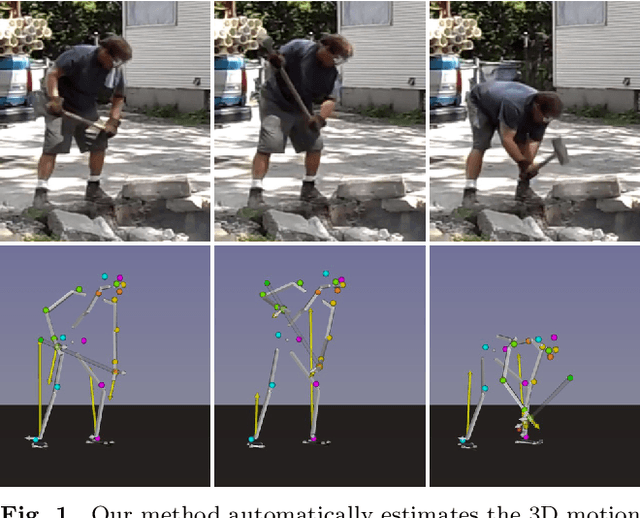



Abstract:In this paper, we introduce a method to automatically reconstruct the 3D motion of a person interacting with an object from a single RGB video. Our method estimates the 3D poses of the person together with the object pose, the contact positions and the contact forces exerted on the human body. The main contributions of this work are three-fold. First, we introduce an approach to jointly estimate the motion and the actuation forces of the person on the manipulated object by modeling contacts and the dynamics of the interactions. This is cast as a large-scale trajectory optimization problem. Second, we develop a method to automatically recognize from the input video the 2D position and timing of contacts between the person and the object or the ground, thereby significantly simplifying the complexity of the optimization. Third, we validate our approach on a recent video+MoCap dataset capturing typical parkour actions, and demonstrate its performance on a new dataset of Internet videos showing people manipulating a variety of tools in unconstrained environments.
History Aware Multimodal Transformer for Vision-and-Language Navigation
Oct 25, 2021

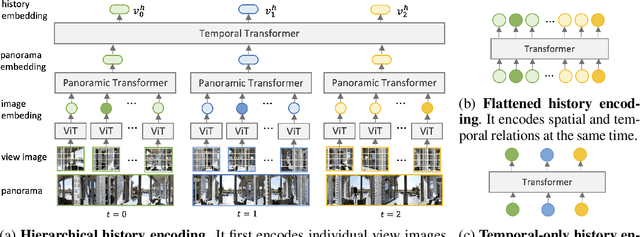

Abstract:Vision-and-language navigation (VLN) aims to build autonomous visual agents that follow instructions and navigate in real scenes. To remember previously visited locations and actions taken, most approaches to VLN implement memory using recurrent states. Instead, we introduce a History Aware Multimodal Transformer (HAMT) to incorporate a long-horizon history into multimodal decision making. HAMT efficiently encodes all the past panoramic observations via a hierarchical vision transformer (ViT), which first encodes individual images with ViT, then models spatial relation between images in a panoramic observation and finally takes into account temporal relation between panoramas in the history. It, then, jointly combines text, history and current observation to predict the next action. We first train HAMT end-to-end using several proxy tasks including single step action prediction and spatial relation prediction, and then use reinforcement learning to further improve the navigation policy. HAMT achieves new state of the art on a broad range of VLN tasks, including VLN with fine-grained instructions (R2R, RxR), high-level instructions (R2R-Last, REVERIE), dialogs (CVDN) as well as long-horizon VLN (R4R, R2R-Back). We demonstrate HAMT to be particularly effective for navigation tasks with longer trajectories.
Differentiable Rendering with Perturbed Optimizers
Oct 18, 2021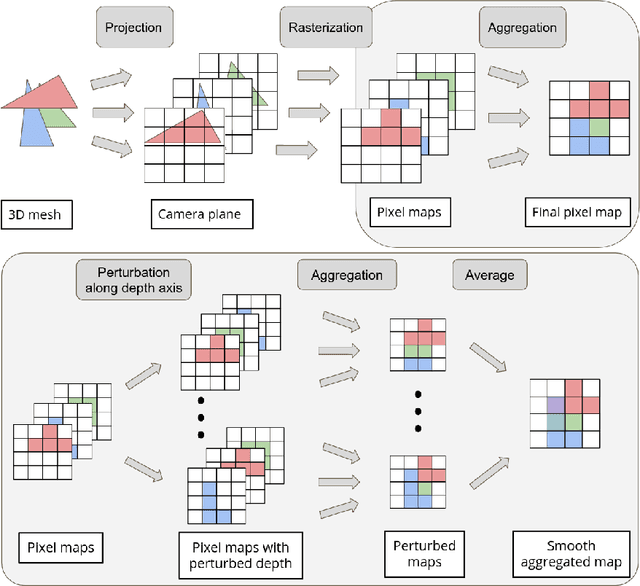
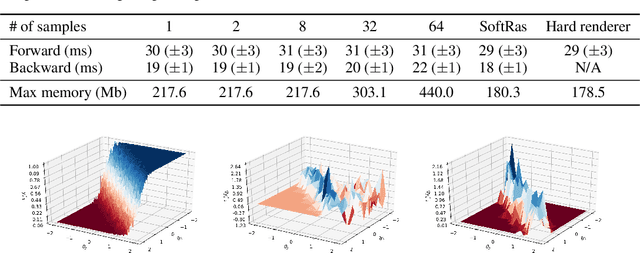

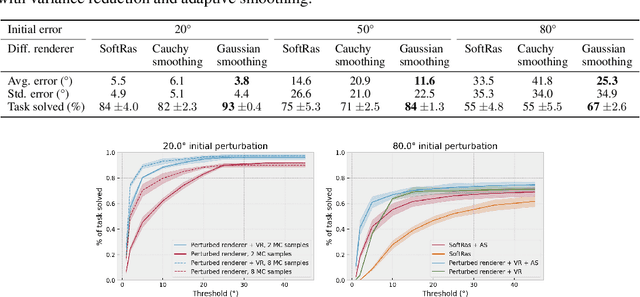
Abstract:Reasoning about 3D scenes from their 2D image projections is one of the core problems in computer vision. Solutions to this inverse and ill-posed problem typically involve a search for models that best explain observed image data. Notably, images depend both on the properties of observed scenes and on the process of image formation. Hence, if optimization techniques should be used to explain images, it is crucial to design differentiable functions for the projection of 3D scenes into images, also known as differentiable rendering. Previous approaches to differentiable rendering typically replace non-differentiable operations by smooth approximations, impacting the subsequent 3D estimation. In this paper, we take a more general approach and study differentiable renderers through the prism of randomized optimization and the related notion of perturbed optimizers. In particular, our work highlights the link between some well-known differentiable renderer formulations and randomly smoothed optimizers, and introduces differentiable perturbed renderers. We also propose a variance reduction mechanism to alleviate the computational burden inherent to perturbed optimizers and introduce an adaptive scheme to automatically adjust the smoothing parameters of the rendering process. We apply our method to 3D scene reconstruction and demonstrate its advantages on the tasks of 6D pose estimation and 3D mesh reconstruction. By providing informative gradients that can be used as a strong supervisory signal, we demonstrate the benefits of perturbed renderers to obtain more accurate solutions when compared to the state-of-the-art alternatives using smooth gradient approximations.
Reconstructing and grounding narrated instructional videos in 3D
Sep 10, 2021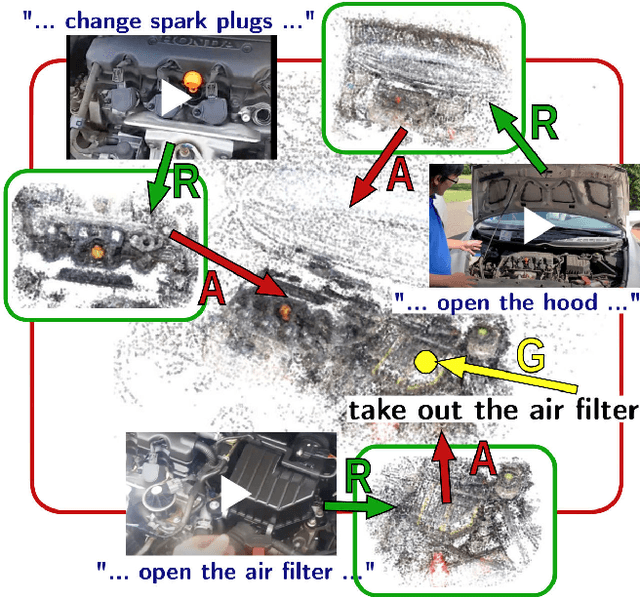
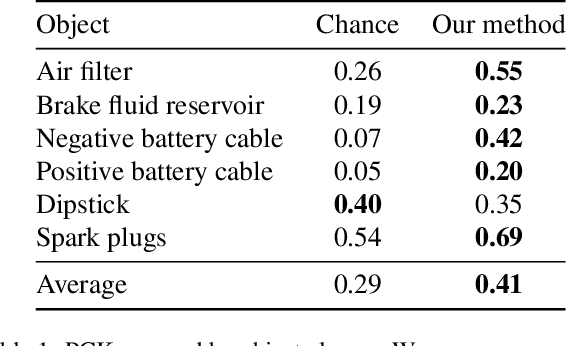


Abstract:Narrated instructional videos often show and describe manipulations of similar objects, e.g., repairing a particular model of a car or laptop. In this work we aim to reconstruct such objects and to localize associated narrations in 3D. Contrary to the standard scenario of instance-level 3D reconstruction, where identical objects or scenes are present in all views, objects in different instructional videos may have large appearance variations given varying conditions and versions of the same product. Narrations may also have large variation in natural language expressions. We address these challenges by three contributions. First, we propose an approach for correspondence estimation combining learnt local features and dense flow. Second, we design a two-step divide and conquer reconstruction approach where the initial 3D reconstructions of individual videos are combined into a 3D alignment graph. Finally, we propose an unsupervised approach to ground natural language in obtained 3D reconstructions. We demonstrate the effectiveness of our approach for the domain of car maintenance. Given raw instructional videos and no manual supervision, our method successfully reconstructs engines of different car models and associates textual descriptions with corresponding objects in 3D.
 Add to Chrome
Add to Chrome Add to Firefox
Add to Firefox Add to Edge
Add to Edge